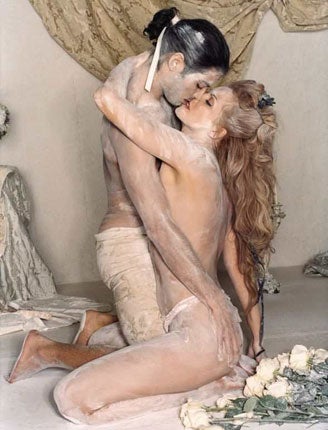More than a handful: Big Books
Costing thousands of pounds and weighing tens of kilograms, the latest photo books are monumentally grand. John Walsh takes a flick

You are a movie fan. You have a library of books on filmic themes. You’ve seen The Godfather and admire it greatly. So when you hear that The Godfather Family Album has been published by the German firm Taschen, with on-set photographs by the legendary snapper Steve Schapiro, you think you’ll treat yourself. You discover the book is large (17 inches by 11,) comes in a box, has 444 pages, is limited to 1,000 copies – and costs £400.
Four hundred quid? For a book of photos? Who are the thousand people who can afford a luxury like that? But the price of coffee-table books has gone a little mad since the days when a Thames & Hudson book on Chagall might set you back £20. This autumn, Taschen brought out a ravishing, extremely heavy, 670- page monster called The Circus 1870- 1950. It cost £120, which seemed a bit steep for a flick-through volume of pictures of trapeze artists.
But if you drop into the Taschen shop in London’s Chelsea, you discover that the luxury book market is booming like a volcano. Wool, a celebration of the messy abstract art of New Yorker Christopher Wool is available at £600, as is America Swings, a mildly emetic study of strenuous sexual misconduct in the US Bible belt. Both are in limited editions – the latter with a print run of only 100, and you get a special “chromogenic” print of a naked Viking and his girlfriend, gratis.
You might consider blowing £700 on Guts and Glory: The Golden Age of American Football – sports photographs by Neil Leifer, limited to 200 signed copies. This is, however, a trifle when put beside Koons, a £2,000 study of Jeff Koons’s entire glossy oeuvre, published in an edition of 1,500 signed copies. You wonder what strange land you’ve walked into, where, in the depths of recession, there are punters willing to pay a king’s ransom for a collection of photographs and a cardboard slipcase. Then you spot another Taschen volume which seems to provide an answer.
The Book of Olga costs £300 and offers 154 pages of photos, by Bettina Rheims, of a young Russian beauty called Olga Rodionova in athletic states of undress: posing ecstatically on bath, clad in PVC or a basque, dusted in flour, being fondled by ladies and gentlemen.
The book was commissioned by her husband, “a Russian oligarch” to show off his missus. Purchasing this volume, therefore, makes you a voyeur in the marriage of Olga and her oligarch, as if the couple were your friends. Is it only oligarchs who can afford to buy such books? “It’s a mixed bag,” says Roy Endicott, of Taschen UK, “They’re bought by rich foreigners, especially Russians and Italians, but they’ve a very multicultural appeal. Celebrities like them, models, pop stars, architects, fashion designers, the rich and famous – even in an economic downturn there are still wealthy people looking for prestigious presents.
And they’re treated as investments. In limited editions, the retail price of the unsold books goes up every year.” He instanced the first mega-book, Sumo, a collection of Helmut Newton photographs bound in a volume so massive it had to be displayed on a table designed by Philippe Starck. “We published 10,000 of them, nine years ago, at £1,000 each. The last ones are going now for £4,500 each.”
Taschen isn’t the only purveyor of monster books. It’s obsessed with bigness (see its The Big Book of Breasts) and so is Kraken Opus, a London-based publisher of enormotomes.
The company’s stated aim is Homeric: “Kraken Opus was formed to create the most epic, stunning, iconic publications ever seen in the world of sport and entertainment on a scale never achieved before.”
The merchandise is massive: a series of huge (800-plus page) books that celebrate football clubs (Manchester United, Arsenal, Celtic), sports (Formula One, the Superbowl), sporting heroes (Maradona) and fashion divas (Vivienne Westwood). The Vivienne Westwood Opus is a thing of considerable beauty: its edition of 900 is split between nine different jackets; each books weighs 25kg, is signed by the grande dame and is obviously the ideal Christmas gift at £1,400.
The company’s most ambitious work, however, is the Saatchi Opus, a giant catalogue of 150 artists who have exhibited in the Saatchi Gallery. The book comes in a wooden art crate; you have to jemmy it open – after spending £2,250 on it. There are even larger luxury books around.
At the top of the tree is Gloria, a British publisher whose ambitions out-vault even Kraken Opus. Having sold two huge tomes called Superyacht and Pele, it is bringing out New York, which resembles a building. Its 756 pages feature 1,200 images of New York by David Bailey, Weegee, Cartier-Bresson, Alfred Steiglitz and Annie Leibovitz, along with articles by Tom Wolfe and John Updike. The £7,500 book comes in a Perspex “tower display stand” which looks like a skyscraper.
“Lots of people are buying it as a piece of room design,” says Digby Halsby, who worked on Taschen’s legendary GOAT, a tribute to Muhammad Ali (the title stands for Greatest Of All Time), “We’re trying to take the coffee-table book to new extremes.” Roy Endicott agrees. “These aren’t just books, but bits of publishing history, pieces of furniture, works of art.”
In 1984, when Benedikt Taschen bought the rights to Reinhart Wolf’s photographs of New York skyscrapers, he priced the book at 168 marks (about £40). Sales were terrible, so he dropped the price to DM30; sales skyrocketed. How times change.
Join our commenting forum
Join thought-provoking conversations, follow other Independent readers and see their replies
Comments
Bookmark popover
Removed from bookmarks